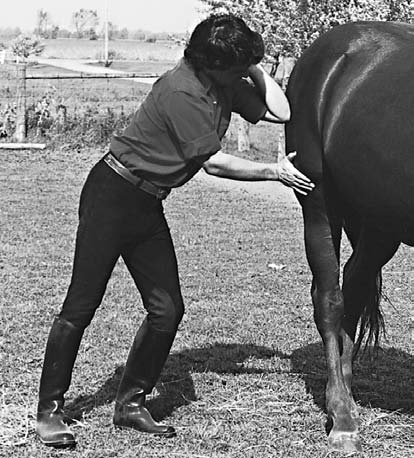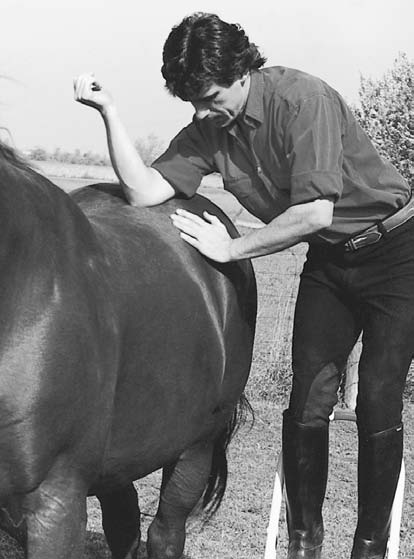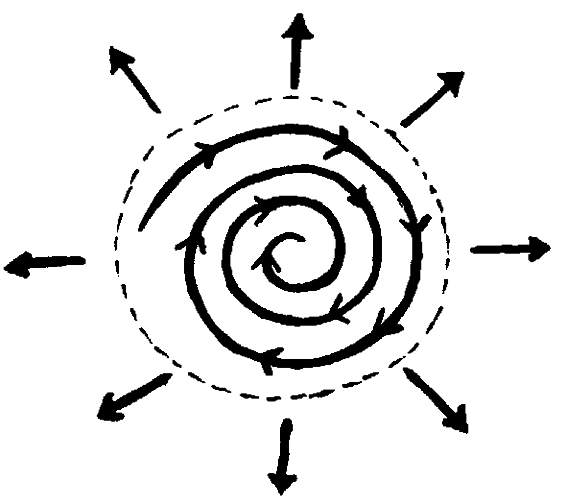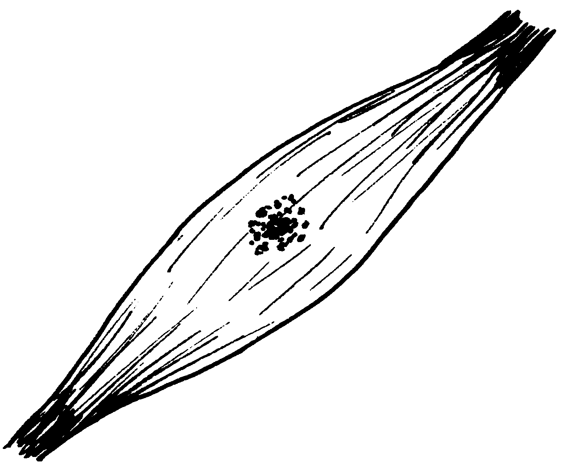Equine Massage: A Practical Guide (21 page)
Read Equine Massage: A Practical Guide Online
Authors: Jean-Pierre Hourdebaigt

To maximize your strength when using the thumb during frictions or when applying deep pressure, use your body weight.You should feel the force going in a straight line from the shoulder through the elbow, the thumb, and to the target. Allow the elbow or the wrist to bend only a few degrees. Proper posture will facil-itate your work and save your energy. The level of pressure used with the thumb depends on the condition of the tissues being treated and the location of the treatment. Use your judgment, but remember that pressure above 25 pounds may bruise the muscles.

100
Equine Massage
If your thumb is not strong enough, you can resort to using your index finger, reinforced with your thumb and middle finger (see figure 5.1[B]) in a similar fashion.
The Elbow Technique
The elbow technique can be used in two different ways. One way is to use the elbow and the forearm to stroke large muscle groups, like an effleurage, to stimulate circulation and thus warm up the area before deeper work. This allows more efficient coverage of larger surfaces and it delivers a nice soothing feeling to the horse.
When using the elbow technique to stroke, give the horse an idea of what you are doing without shocking him: make your first pass extremely gentle (2 or 3 pounds of pressure). Then work progressively deeper with each pass: 5, 8, 10, 15, and 20 pounds of pressure—
but no more. This technique is very mechanical; it will trigger a massive reaction, stimulating circulation and loosening muscle fibers, tendons, and ligaments.Your elbow is a large, strong bone; use it wisely and carefully. Pay attention to the animal’s feedback signs. It is recommended that you thoroughly warm up all areas before starting deeper work.
The other way to use the elbow technique is to use the tip of the elbow to apply heavy pressure over stress points or trigger points on large muscle groups—for example, the hindquarters or back muscles. Use your fingers or thumbs to detect stress points or
5.3 Elbow Technique

Massage Techniques
101
5.4 Elbow Technique:
Using a stool to position
yourself better
trigger points, then carefully place the tip of your elbow right over the target and gently apply pressure starting at around 10 pounds.
Then build up the pressure using your body weight. Do not exceed 25 to 30 pounds, depending on the location and the size of the muscle groups. The tip of your elbow and its sharpness reach very deeply into the tissues. Hold the point between 20 to 60 seconds (on average) until you feel the release. Occasionally it takes 2
or 3 minutes for chronic points to release, but no more. Intersperse with lots of effleurages to drain the area every 20 or 30 seconds.
Be careful not to overwork the tissues in one treatment.
In either application you must position yourself properly. Stand on a stool so that you stand directly above the area to be worked on. In this way, you will be able to apply your body weight effectively, thus conserving your energy while you work. Leave enough space between you and the horse so you can move if you need to glide your elbow.To ensure your comfort and safety, make sure the stool is strong and wide enough.
With practice, you will become adept at this very effective technique and will use it often. It saves much work on the thumbs, especially with animals that have a lot of muscle mass.

102
Equine Massage
The Swelling Technique
A swelling results from trauma—such as a strain, sprain, wound, kick, inflammation from overwork, or the flare-up of an old injury—because an increased amount of fluid (lymph or blood) comes to the affected area. An excess of fluid increases tension in the skin and renders it very sensitive to touch.The temperature of the swollen area will be higher than normal relative to the degree of inflammation. Use a very light pressure, 1 to 3 pounds, to avoid mechanical stress on the skin and deeper tissues.
Before applying the swelling technique described below, first apply hydrotherapy (chapter 4): cold in acute cases, vascular flush (hot/cold) in subacute cases, and hot in chronic cases.
When the case calls for cold hydrotherapy, the ice cup massage is a terrific, practical technique to use with swellings. Choose the most practical device (hose, ice cup) available to you and apply it before your massage treatment to induce vasoconstriction and numbing of the nerve endings.
Also, at the end of your massage treatment, apply cold hydrotherapy to reduce nerve irritation and cause vasoconstriction to aid the drainage effect. The cold application’s secondary effect will contribute to the overall circulation of fluids in the treated area.
The swelling technique starts with some light stroking moves over the body to relax the animal and help him accept your working close to the problem site. Then apply light strokings over the swollen area to soothe the irritated nerve endings. Your rhythm should be at a relaxed pace of 1 move per second.When the initial tenderness seems to be relieved, you can use a fine vibration movement to stimulate the circulation. Then resume the light strokings. Weave your strokes into very light effleurages (2 or 3
pounds of pressure maximum)
around the periphery of the
swollen area, draining toward
the heart.This will help stimulate circulation and begin the
drainage process.
Keep a
relaxed pace of 1 move per second.
Next, proceed with a very
gentle double-thumb kneading
massage at the edge of the
swelling,
going clockwise
around the damaged area and
5.5 Schematic Diagram of
draining excess fluid toward
Swelling Technique
the outside of the swollen area.
Massage Techniques
103
Always start on the outside, not at the center. Use 3 to 5 pounds of pressure or less if the skin is very tight or tender. Even when light pressure is used, the mechanical effect will be sufficient to induce drainage rapidly. Once you have completed the circumference of the swollen area, use light but thorough effleurage, draining away from the periphery of the trauma and always moving toward the heart.
Repeat the kneading technique, progressing in a spiral fashion toward the center of the problem area, alternating with effleurages at the completion of each kneading movement around the circumference of the area.
When there is a considerable decrease in the swelling, use more effleurage, progressively with more pressure but never in a heavy manner. You might slightly increase the rhythm of your moves.
Estimate the degree of inflammation and tenderness and adjust your pressure and pace.
Duration of Application
Over a small area 2 or 3 inches in diameter, the application should not last more than 5 minutes in order to avoid irritating the skin.
Over a larger area, 10 to 15 inches in diameter, the application should not last more than 10 minutes.
If the swollen area is very large (an entire leg or hindquarter), do not exceed 20 minutes. Use palmar kneading instead of thumb kneading to cover more area, but do not use heavy pressure.
Remember that the tissues are very tender and a gentle pressure is enough to cause a mechanical rerouting of the excess fluid.
Always keep a relaxed rhythm of 1 move per second.
Evaluate the condition—the degree of swelling, inflammation, and tenderness. It is best to do several small treatments over the course of 1 or 2 days and thus achieve a steady rate of recovery.
By attempting large treatments in a short period you take the risk of aggravating the inflammation and delaying the healing process.
When dealing with the swelling of the lower leg, first gently but thoroughly massage the upper leg to stimulate circulation. Ice massage does wonders for lower leg edema. When dealing with the foreleg, you can use one hand to flex the knee to raise the lower leg to a 90-degree angle, and work the tendon thoroughly with the other hand, using mostly effleurage moves. Here your overall treatment should not exceed 20 to 25 minutes.
Follow this swelling technique with a cold hydrotherapy application (chapter 4) to reduce nerve irritation and to cause vasoconstriction to further the drainage effect. The secondary lasting vasodilation effect of the cold application will affect circulation.
104
Equine Massage
Frequency of Treatment
The degree of inflammation present in the tissues will determine the frequency of your treatments. If the inflammation is very severe in a small area, apply the swelling technique only once or twice a day. If it is in a large area, apply just once a day. However, you can apply cold hydrotherapy several times a day (up to 10
times) for 10 minutes at a time.
If the inflammation is moderate, the swelling technique can be repeated 2 or 3 times a day, with a minimum of 6 hours between treatments.When dealing with a larger area such as a leg, you may work this technique twice daily. As the swelling goes down and the tissues become less tender, you can use more pressure and more effleurages.
Be gentle and very careful in the acute stage, becoming more invasive gradually as the site of swelling gets better. Remember to use hydrotherapy before, after, and in between the treatments to reduce inflammation.
In the case of a flare-up of an old injury, relieving the swelling might take twice as many treatments as in an acute injury, due to the chronic nature of the inflammation. If tenderness is present in the tissue, the use of cold hydrotherapy might be more beneficial than heat. But if the nerves do not appear to be irritated, use heat or vascular flush (see chapter 4). Once the swelling is definitely gone, resume regular massage practice.
The Trigger Point Technique
The trigger point technique is used to release and drain trigger points.
This condition occurs mostly in response to muscle tension (overuse) or nervous stress; it is sometimes the result of poor circulation. The
hypertonicity
(strong/well-used) or
hypotonicity
(weak/unused) of the muscle fibers causes a decrease in blood circulation and thus a decrease in oxygen, resulting in a build up of toxins and nerve irritation. Muscular tension is mostly due to overwork with not enough stretching or rest. Too much fatigue, nervous stress, restlessness, and boredom can trigger the same muscular tension.
When the triggered pain is of low intensity, it is called a
silent
trigger point
; when the triggered pain is strong and very sensitive to touch, it is termed an
active trigger point.
Occasionally, one trigger point will affect more than one area; these are called
spillover areas.
Trigger points vary in size and can feel like nodules.Whatever the size, they are usually very tender, give easily under pressure, and release fairly quickly. Hot hydrotherapy application over the
